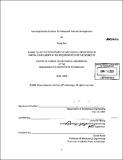Nanoengineered surfaces for advanced thermal management
Author(s)
Xiao, Rong, S.M. Massachusetts Institute of Technology
DownloadFull printable version (32.35Mb)
Other Contributors
Massachusetts Institute of Technology. Dept. of Mechanical Engineering.
Advisor
Evelyn N. Wang.
Terms of use
Metadata
Show full item recordAbstract
Thermal management is a critical challenge for a variety of applications including integrated circuits (ICs) and energy conversion devices. As the heat fluxes exceed 100 W/cm2, novel cooling solutions need to be developed. Thin film evaporation is a promising approach because the large latent heat associated with phase change can be utilized while the thermal resistance associated with the liquid film thickness can be minimized. However, traditional thin film evaporation schemes such as jet impingement and sprays suffer from several limitations, such as high power consumption, complex flow patterns, and localized cooling. In this thesis, micro- and nanostructured surfaces were investigated to enhance fluid and heat transport for thin film evaporation. This thesis includes studies of fluid interactions on surfaces with micro- and nanopillar arrays with diameters and spacings ranging from 500 nm to 10 [mu]m. First, liquid transport studies were performed where a propagating liquid on an array of pillars with scalloped features can separate into multiple layers of liquid films. The scallops were found to act as energy barriers that favored liquid separation into several layers. An analytical model based on surface energy was developed to explain the phenomenon and was validated by experiments on additional tailored pillar geometries. Subsequently, a semi-analytical model was developed to predict the propagation velocity based on Modified Washburn's Model to optimize propagation of the liquid. The results were validated by measurements of liquid propagation velocity on micropillar arrays with various geometries. (cont.) Finally, the heat transfer performance was investigated on microstructure pillar arrays with integrated heaters and temperature sensors. These test devices were fabricated and the behavior of the thin liquid film under varying heat fluxes was investigated, where a two-step "dry-out" behavior was observed. The thermal resistance of the thin film including the effect of the micropillars was also analyzed. This work demonstrates the potential of micro- and nanostructures to achieve high heat fluxes via thin film evaporation.
Description
Thesis (S.M.)--Massachusetts Institute of Technology, Dept. of Mechanical Engineering, 2009. Includes bibliographical references (leaves 53-54).
Date issued
2009Department
Massachusetts Institute of Technology. Department of Mechanical EngineeringPublisher
Massachusetts Institute of Technology
Keywords
Mechanical Engineering.